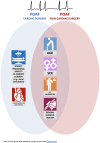Postoperative atrial fibrillation: from mechanisms to treatment
- PMID: 36721960
- PMCID: PMC10226752
- DOI: 10.1093/eurheartj/ehad019
Postoperative atrial fibrillation: from mechanisms to treatment
Abstract
Postoperative atrial fibrillation (POAF) is the most common type of secondary atrial fibrillation (AF) and despite progress in prevention and treatment, remains an important clinical problem for patients undergoing a variety of surgical procedures, and in particular cardiac surgery. POAF significantly increases the duration of postoperative hospital stay, hospital costs, and the risk of recurrent AF in the years after surgery; moreover, POAF has been associated with a variety of adverse cardiovascular events (including stroke, heart failure, and mortality), although it is still unclear if this is due to causal relation or simple association. New data have recently emerged on the pathophysiology of POAF, and new preventive and therapeutic strategies have been proposed and tested in randomized trials. This review summarizes the current evidence on the pathogenesis, incidence, prevention, and treatment of POAF and highlights future directions for clinical research.
Keywords: Mechanisms; Postoperative atrial fibrillation; Treatment.
© The Author(s) 2023. Published by Oxford University Press on behalf of the European Society of Cardiology. All rights reserved. For permissions, please e-mail: journals.permissions@oup.com.
Conflict of interest statement
Conflict of interest: Dr. Gaudino receives grant funding from the National Institutes of Health and the Canadian Institutes for Health and Research. Dr Di Franco has consulted for Servier, Novo Nordisk, and is an Advisory Board Member for Scharper. Michael Mack is a member of Steering Committee for AbbVie POAF Trial and Senior Vice President of CTSN Network. The other authors have no disclosures.
Figures





References
Publication types
MeSH terms
Grants and funding
LinkOut - more resources
Full Text Sources
Medical

